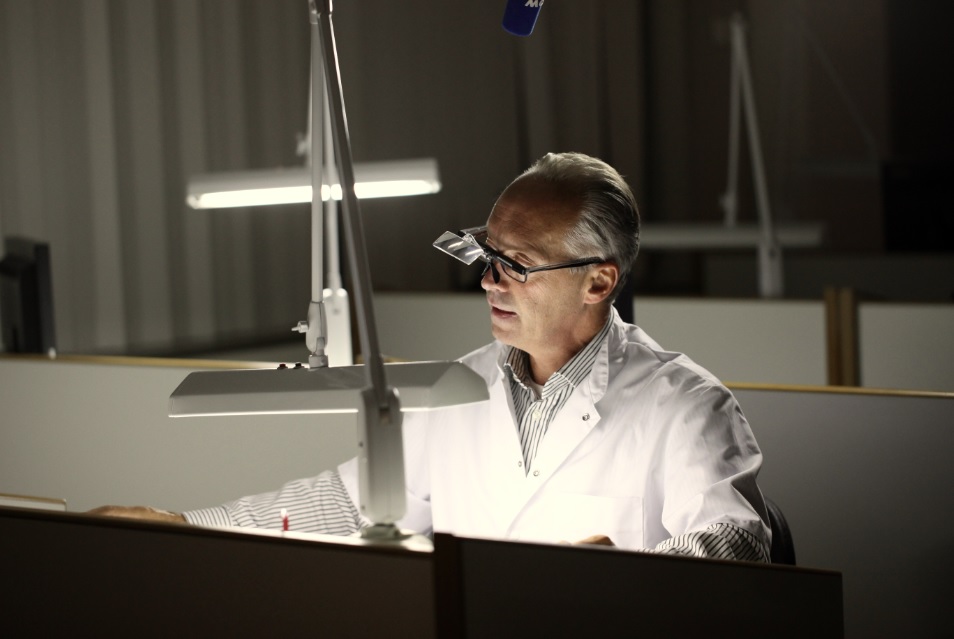|
|
Certified Delays
Backlogs at GIA Reflect Rising Demand for Diamond Certificates
Feb 7, 2014 8:00 AM
By Avi Krawitz
|
|
|
RAPAPORT... Diamond manufacturers are frustrated by the long turnaround time of goods being sent to the Gemological Institute of America (GIA) for certification. The recent delays have stemmed from a steady rise in demand for certificates as the GIA’s intake has increased sharply in the past year, which has led to a buildup of inventory at its laboratories.
Thomas Moses, GIA's executive vice president and chief laboratory and research officer (pictured, courtesy GIA), told Rapaport News that the company’s inventory is currently more than 50 percent above normal levels due to an “exceptional intake of diamonds.”
As a result of the backlog, the GIA posted on its website that goods submitted this week to its Carlsbad lab will take 50 to 55 days for dossier certificates and 40 to 45 days for its regular diamond grading reports. Similar time frames are given for its New York and Mumbai locations. Moses recognized the turnaround time should be only five to 10 days for any intake and sensed the frustration of the market.
“In my opinion, it’s a scandal,” said an Antwerp-based manufacturer, who requested to remain anonymous. “We work hard to reduce our manufacturing [time] and polish goods within 60 days, and then we’re at the mercy of the labs who return the diamonds two months later. It’s ridiculous.”
Moses responded that the GIA’s board recently approved the most aggressive hiring and expansion plan in its history in an effort to meet the rising demand. Primarily, the program entails increasing its lab staff by 50 percent at all of its locations. The GIA also recently enlarged its lab space in India, renovated its facilities in Thailand and is moving to bigger New York premises next month.
Moses cautioned, however, that the delays are likely to continue in the short term as it takes about six months of training to get new recruits ready to contribute to the production line. Furthermore, trainees are mentored, which affects the productivity of the more experienced gemologists.
“We see no way to make the impact immediate if the intake remains as high as it is, which it seems it will,” he explained. “I expect that by mid-year we will start to feel a difference, but we will only see a more meaningful improvement later in the year.”
Small Stone Demand
The volume of diamonds being sent for grading is expected to remain high as diamond manufacturers have raised their rough buying and polished production levels in the past month. There has also been an increase in demand for GIA’s diamond dossiers, with particularly strong demand for 0.30-carat to 0.50-carat certified diamonds, continuing the trend seen throughout 2013. Dossiers are a more concise report that is available for diamonds weighing 0.15 carats to 1.99 carats only.
While prices for larger diamonds declined in 2013, the RapNet Diamond Index (RAPI™) for 0.30-carat diamonds rose 10.1 percent during the year and increased another 1.6 percent in January. Moses noted that the GIA’s backlog is mostly due to the large intake of small stones below 0.40 carats.
Roland Lorie, co-CEO of the International Gemological Institute (IGI), explained that economic trends have influenced the rising popularity of smaller certified diamonds. “Consumers have become more price conscious,” he said. “There’s been a shift toward the very expensive goods and the lower price points, with a bit of erosion in demand for goods in between.” Lorie reported that IGI – which also provides quality assurance for jewelry to retailers – is receiving a lot of rings set with three smaller stones rather than one large center diamond as the combined cost of the smaller diamonds is less than the price of the larger stone.
Lorie added that dealers have also recognized that they can make more money by selling certified diamonds than by selling their diamonds in parcels. “You don’t see parcels of 30 pointers in the market anymore,” he observed. “Indian manufacturers used to sell parcels in Antwerp, Israel and New York, where the commercial decisions would be made on which goods to certify. Now, manufacturers are making those decisions themselves. They realize they can make more money by selling each individual diamond with a certificate.”
Consumer Confidence
While current demand is strongest for smaller certified diamonds, the gradual increase in demand for certificates has affected all sizes and categories as consumers seek greater assurances in their purchases.
Jonathan Kendall, head of operations at Forevermark, the De Beers diamond brand, explained that De Beers research found consumers to be more concerned about the authenticity of the product they’re buying, which has led to their demand for some kind of assurance that they’re buying a real item with genuine value.
“There’s been a slow momentum in the past seven years that has led to greater demand for diamond certification,” Kendall said. “It has now become the norm that people expect to have something to confirm what they are buying.”
He stressed that the internet has also influenced a spike in demand for certificates as consumers have access to more information about diamonds and have gained greater knowledge about certificates. Kendall noted that the trend is especially strong in China as consumers there are naturally cautious purchasers who use the internet extensively to learn about the diamonds they intend to buy. “China may have an even stricter consumer mentality about understanding what they’re purchasing,” he said.
The internet is also playing a stronger role within the trade, evidenced by the importance of business-to-business platforms such as RapNet – Rapaport Diamond Trading Network, Polygon, Idex and others.
“Businesses don’t need to invest in sales and marketing as they used to,” explained a Mumbai-based manufacturer, who requested anonymity. “Why reach out to a client when you can simply list the stone on RapNet with all specifications provided by the certificate and price transparency? And why would I choose to be in the business of [very] small diamonds that need a full sales force, when I can polish certified goods and sell them online? It’s so easy.”
Branding Opportunity
As more people have access to information about diamonds, new opportunities have opened to the industry. Lorie noted that greater awareness about certificates has complimented the trend among the younger generation toward quality assurance and brands – which the laboratory’s certificate can also provide.
With very few diamond brands in the market, he explained that the laboratories have become the recognizable brand to the consumer. “The diamond and jewelry trade is one of the few industries where quality assurance is provided by a third party and not the seller,” he said. “So while consumers may know and trust their jeweler, they want to see brands in the store and the certificate plays that role.”

As part of its branding efforts, Forevermark started its own grading service in 2009 to complement the “full promise” that Forevermark is selling to the consumer, Kendall explained. He noted that all Forevermark diamonds above 0.30 carats are graded in-house, with hundreds of thousands of diamonds having passed through the Forevermark laboratories since its launch. (Pictured: Forevermark gemologist. Courtesy Forevermark).
Kendall reported that De Beers is planning to start grading generic diamonds, or non-Forevermark goods, in the near future through its subsidiary, the International Institute of Diamond Grading and Research (IIDGR).
“At this point, we’re assessing whether we will be only supporting our existing clients or the industry as a whole, whereby we would be issuing a De Beers grading certificate,” he explained. “There’s a lot of power in our business and in our history, and a lot of retailers see great advantage in having a stone certified by De Beers. So there’s an opportunity there that we aren’t going to ignore.”
De Beers is therefore expanding its grading business and has plans to open a laboratory in Surat, India in the first quarter of 2015, as well as programs to expand its Forevermark labs in Antwerp and the UK.
Quality Controls
Given all these trends, Lorie notes that there has been an overall rise in demand for gemological services apart from diamond grading. For example, he reported that IGI is receiving a lot of parcels of very small melee diamonds to check if synthetic diamonds have inadvertently been included in the mix. Most laboratories and others in the industry – including the Rapaport Group – today offer this service.
Moses added that part of the delays at the GIA is due to its reputation for top quality, especially when it comes to detecting treatments and synthetics. As consumers increasingly seek that security and assurance, Moses stressed that GIA’s strategy and challenge with the current backlog is to grow as quickly as possible, but to also maintain the quality of its work.
Martin Rapaport, chairman of the Rapaport Group, cautioned the trade not to blame the GIA for slowing the market down, as quality needs to be upheld. “Diamond grading reports provide vital authentication and gemological information that protects the integrity of the diamond industry,” Rapaport said. “Recent backlogs at the GIA are evidence of increasing demand for diamond documentation. Complaints by the trade about delays are misplaced because the GIA’s number one priority must be to maintain the accuracy and consistency of its grading system.”
The writer can be contacted at avi@diamonds.net.
Follow Avi on Twitter: @AviKrawitz and on LinkedIn.
This article is an excerpt from a market report that is sent to Rapaport members on a weekly basis. To subscribe, go to www.diamonds.net/weeklyreport/ or contact your local Rapaport office.
Copyright © 2014 by Martin Rapaport. All rights reserved. Rapaport USA Inc., Suite 100 133 E. Warm Springs Rd., Las Vegas, Nevada, USA. +1.702.893.9400.
Disclaimer: This Editorial is provided solely for your personal reading pleasure. Nothing published by The Rapaport Group of Companies and contained in this report should be deemed to be considered personalized industry or market advice. Any investment or purchase decisions should only be made after obtaining expert advice. All opinions and estimates contained in this report constitute Rapaport`s considered judgment as of the date of this report, are subject to change without notice and are provided in good faith but without legal responsibility. Thank you for respecting our intellectual property rights.
|
|
|
|
|
|
|
|
|
|
Tags:
Avi Krawitz, diamonds, Forevermark, GIA, IGI, Rapaport
|
|
|
|
|
|
|
|
|
|
|

|
|